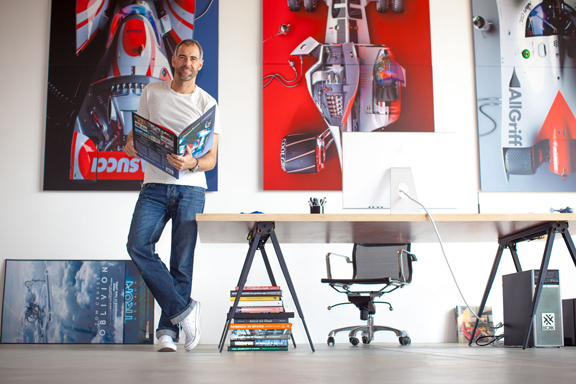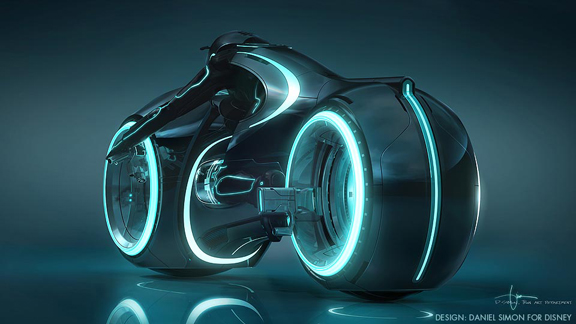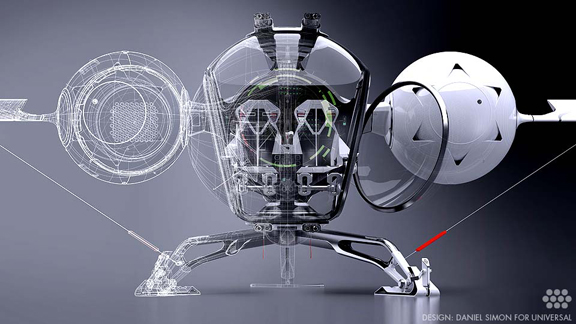
Daniel Simon (XXX), featured in the whitepaper “Making the Case for Visual Collaboration,” dreams up vehicles not only for car studios but also for Hollywood films. His arsenal is a BOXX workstation equipped with four NVIDIA GPUs.
Latest News
October 27, 2015
 Daniel Simon, featured in the whitepaper “Making the Case for Visual Collaboration,” dreams up vehicles not only for car studios but also for Hollywood films. His arsenal is a BOXX workstation equipped with four NVIDIA GPUs.
Daniel Simon, featured in the whitepaper “Making the Case for Visual Collaboration,” dreams up vehicles not only for car studios but also for Hollywood films. His arsenal is a BOXX workstation equipped with four NVIDIA GPUs.Daniel Simon designs vehicles for two drastically different worlds. Some of his creations, like the Light Cycle and the Hydra Schmidt Coupe, race through the fictional universes depicted in TRON: Legacy and Captain America. His other works, like the Lotus C-01 Motorcycle and the Bugatti Veyron FBG par Hermes, are firmly grounded in the real world of automotive design.
Daniel studied transportation design at the University of Applied Science in Pforzheim, Germany. As someone working in concept design studios, Daniel had much more freedom than typical automotive engineers, but he craved for greater creative outlet. “I did very advanced stuff, the kind you’d see in car shows that blow people’s minds. Yet, it’s still four wheels, four corners, windows, steering wheels—very limited,” he explained.
The futuristic spacecrafts and vehicles in Star Wars, he revealed, inspired him to look in Hollywood’s direction for new design horizons. “The designers who created them became my stars and heroes, as opposed to Darth Vader and Obi-wan Kenobi,” he said, with a chuckle.
Now, when a movie needs an iconic vehicle with personality and pizzazz, Daniel is on the shortlist of people to contact. “It’s a niche market,” Daniel pointed out. He does well in this field because he brings his expertise as an industrial/car designer to the otherwise imaginary spacecrafts and vehicles.
 Tron Lightcycle Design by Daniel Simon. Copyright Disney Enterprises (image courtesy of Daniel Simon).
Tron Lightcycle Design by Daniel Simon. Copyright Disney Enterprises (image courtesy of Daniel Simon). Daniel Simon’s Bubbleship Concept Design for Universal’s Oblivion, directed by Joe Kosinski / with Tom Cruise (image courtesy of Daniel Simon).
Daniel Simon’s Bubbleship Concept Design for Universal’s Oblivion, directed by Joe Kosinski / with Tom Cruise (image courtesy of Daniel Simon).Daniel’s concept-generating engine is the APEXX 5 workstation from BOXX. It’s equipped with four NVIDIA K6000 GPUs to give him all the rendering horsepower he needs. He works in Bunkspeed SHOT, a CAD-friendly rendering package that supports GPU-acceleration. “I’m so obsessed with the photo-realism I can get at the push of a button that my [hand] sketching is suffering a little,” he admitted.
Daniel’s first rendering experiment took place on an Amiga 500 (released in 1987, discontinued 1991). “It was a sphere, a stick, and a cube,” he recalled. “I remember, it took a week.” (He also remembered apologizing to his mom for the anticipated power bill in advance.)
Even when he was working on TRON: Legacy (around 2008-2009), simple turntable animations took overnight to render, he said. “Today I render 12-second-long turntable animations in 1920 HD res at 360 frames, maybe a million polygons, in about four-five hours. [If I] render at a lower res just to get an idea, it’ll be about half hour.”
But don’t think that because he can now render images with less time, he’ll have a lot of idle times. The more he can do, the more work he loads into his workhorse of a workstation. He explained, “The faster NVIDIA’s new card is, the faster BOXX makes their machine, an artist like me will embrace it within the hour. Once we got so used to it, we can’t go back [to slower speed]. The technological advancement, sadly, doesn’t give us free time for a drink or barbecue, because we just fill [the free time] with more possibilities.”
Whereas some designers might begin with hand-drawn sketches or 2D digital sketches first, Daniel said, “If I have everything in my head, it’s almost a waste of time to sit down and sketch it. So I would go directly to 3D in Autodesk Alias.”
In his personal project, a full-color coffee table book dubbed “Timeless Racer,” Daniel’s fictional hero Vic Cooper gets to drive iconic, historic cars from the past and cars destined for the future. The concept vehicles rendered and depicted in the pages are the culmination of Daniel’s own career that cut through the studios of Bugatti, Lotus, and Formula 1, and the distinct vehicles he created for major blockbusters. Danial’s latest work was the Bubbleship ridden by Tom Cruise’s character in the film Oblivion.
For more on Daniel, listen to the podcast interview below and download the whitepaper “Making the Case for Visual Collaboration” in PDF.
Subscribe to our FREE magazine, FREE email newsletters or both!
Latest News
About the Author
Kenneth Wong is Digital Engineering’s resident blogger and senior editor. Email him at [email protected] or share your thoughts on this article at digitaleng.news/facebook.
Follow DE





